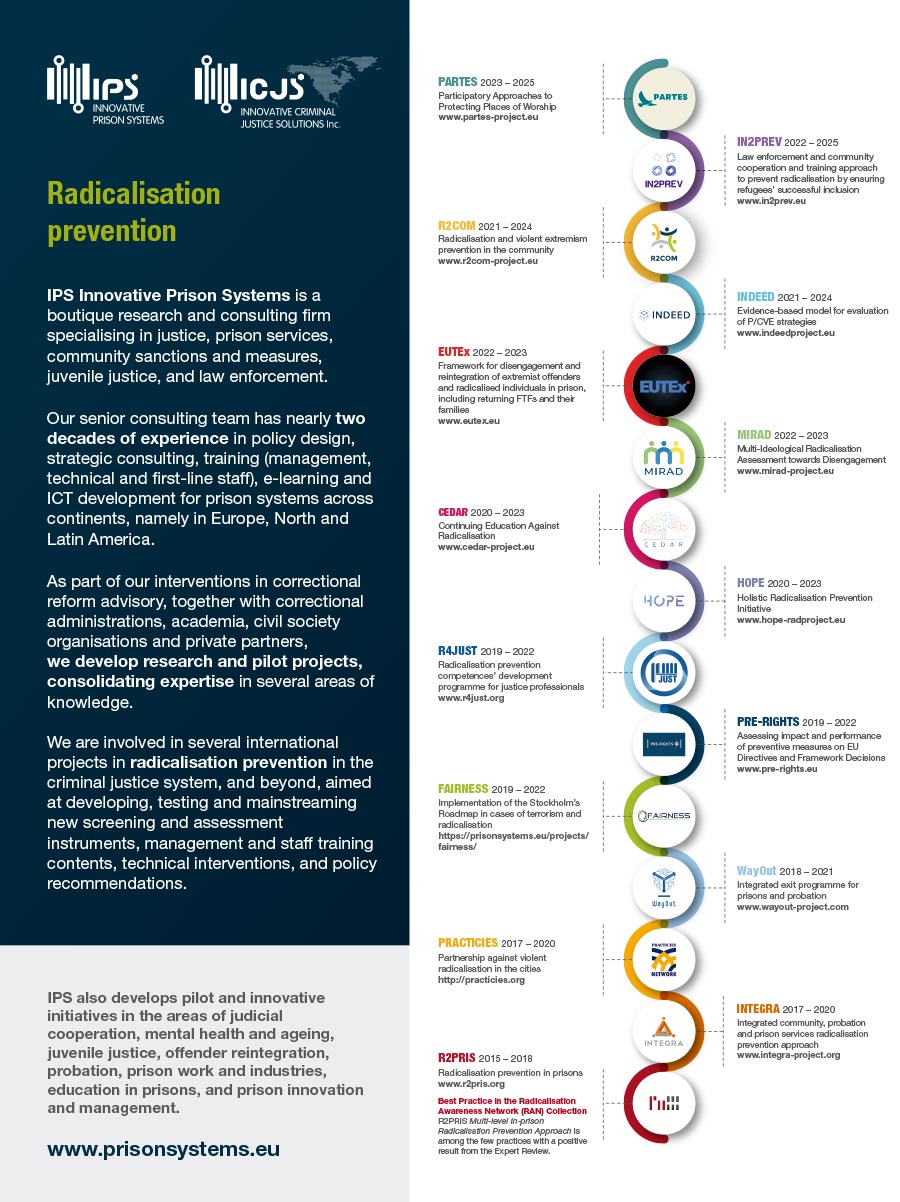Article
Dr Daniela Pisoiu
Successful disengagement and reintegration of extremist and terrorist offenders is crucial – not least to prevent further terrorist attacks. Cases of terrorism recidivists regularly raise questions as to the relevance and effectiveness of disengagement and deradicalisation programmes. Arguably, though, the question is not whether disengagement works, but how to do it best, so that it does work.
Europewide, there is no shortage of exit programmes, methods and approaches developed for this particular target group, or for radicalised individuals without criminal convictions. As is more generally the case with CVE approaches, the question of evaluation is a thorny one, with few concrete indications as to the effectiveness of measures.
Studying current frontline approaches across Europe
In order to gain a sense of what kinds of concrete methods and approaches work in practice, the EUTEx consortium interviewed 47 professionals in 11 European countries, the majority social workers and psychologists, but also including educators, exit workers and similar roles working directly with extremist and terrorist offenders.
The questions addressed the general approach to working with terrorist and extremist offenders, concrete practices in disengagement and deradicalisation as well as risk assessment, transition management, gender, training and more general needs.
The reactions to the questions were surprisingly similar, regardless of whether the interviewees worked in countries with a low or high-density of terrorist or extremist activity. Despite an apparent allure of exceptionalism, the specificity of working with this type of inmate does not require special or entirely new programmes or approaches.
Generally, staff work with methods and practices they employ for other inmates too. The difference usually consists of additions to these existing methods, emphases on certain aspects of the work, or an increased duration and/or intensity of care.
Importantly, knowledge about radicalised environments and radicalisation processes is essential in order to adapt methods adequately. Furthermore, interviewees have stressed that problems faced in the prison environment, such as mobile phones, drugs, and violence, also apply in these cases.
Consequently, general good practice approaches such as dynamic security, are of relevance here too. All interviewees argued that separation regimes are not advisable for the purposes of disengagement and reintegration, which, however, does not exclude the special monitoring and temporary isolation of certain individuals if they engage in proselytism.
Another insight conveyed in the interviews concerns the relationship between disengagement and reintegration; while these two are technically separate concepts, in practice, however, the methods used for the purposes of disengagement and reintegration often overlap.
Furthermore, the output of one approach can influence the other, such as for example when finding a meaningful occupation as a measure of reintegration, at the same time affects disengagement through contact with other social environments and the refocussing on alternative activities.
Separating beliefs from behaviour is a cornerstone of cognitive-behavioural and psychiatric approaches and something that can be observed more broadly in the work with terrorist and extremist offenders. Professionals focus on affecting behaviour, changing motivations, rearranging priorities, changing perspectives and identifying alternatives.
Affecting ideas is not something that can necessarily be achieved during the sentence time, nor something that the justice system should essentially be tasked to do. Important pillars of the rehabilitation and reintegration work in prison are education, vocational training and employment.
Various types of training, such as anti-aggression training and anger management training can also be used for this type of inmate if necessary. Affecting the social environment is a challenging task due to its complexity and the fact that it requires a lengthy period of time; it is therefore an aspect that particularly requires multi-agency efforts. An important aspect that can influence the change of social environment is, again, employment.
Another important point made throughout the interviews was the idea of basic needs, which all inmates have, as opposed to specific needs of the radicalisation process. Interviewees argued that one cannot take care of specific needs if one has not taken care of the basic ones first.
Communities, much like families, can be a positive or a negative factor, the latter when for example certain conservative structures that allocate particular roles affect the perspective for further individual development, especially in the case of women.

Exploring effective methods for establishing a connection
Besides general social work and therapies, interviewees elaborated on specific methods they considered effective. Motivational interviewing was often mentioned in interviews, yet very rarely used in practice.
Working with the biographies of terrorist and extremist offenders is recurrent in the prison and probation settings and can be used for various purposes, from assessing risks and needs to discovering points of contact for interventions.
For example, practitioners look for the drive, the motivation and personal factors that might have led to the commission of the extremist act. Importantly, biographical work also helps identify the possible presence of mental health issues. Creating a relationship, establishing rapport is an initial phase of engaging the client which can be very challenging.
Much of the working alliance means conveying an understanding of the fact that specialists are there to help, and on creating a bond with the client. The duration of this process of establishing rapport and opening up depends on the phase and type of radicalisation. It can also be unsuccessful in singular cases, and the methods of approaching them vary as well.
Some of the methods focus on getting to know the person and being open to topics which initially might not be related to the process at hand. For example, an interviewee mentioned how an inmate was interested in a certain CD cover which he wanted to draw. After obtaining that, he was open for the first time to talk about his biography. People are different and thus the approach needs to adapt to the individual person; importantly, it needs to be afforded the necessary time.
Risk assessment and gender dimensions
While the necessity to conduct risk assessment has not been contested, the type of risk assessment, whether risk assessment tools are used or not, and which type of risk assessment tools are applied, vary from country to country.
Additionally, the use of risk assessment tools alone is regarded as insufficient for the purposes of the concrete rehabilitation and reintegration work, such that additional or modified tools would be needed to address aspects like needs, opportunities, and resources for rehabilitation and reintegration.
This relates to the fact that approaches to disengagement and reintegration build on the risk-need-responsivity model: not only is the dangerousness of the individual in focus, but also their needs and the options to rehabilitate and reintegrate.
A number of other gaps and difficulties were outlined in the interviews. In designing rehabilitation and reintegration programmes and interventions, the gender dimension is barely considered, besides the efforts that aim to provide female case workers. This is mostly due to the small number of women in this group of inmates. In some cases, women are seen as having subordinate roles in extremist movements.
Otherwise, women are perceived as posing a specific set of challenges, in particular those related to the fact that they educate the children, and to the more pronounced cognitive component of their radicalisation process, which includes the solidification of certain societal roles.
Transition management is recognised as equally important, yet a number of challenges are still present such as trust, timing, and continuity of tools and knowledge. There are several models and approaches to transition management. Generally, there appears to be a need for probation services to be engaged prior to release.
False compliance issues intervene especially in situations where there is a fairly routinised system of assessment. Several specific and general training needs were mentioned, not just regarding disengagement and reintegration practices, but also with regards to updated knowledge on extremist scenes, radicalisation, and disengagement.
The EUTEx project contribution
Based on these insights, as well as on a survey of existing practices in the area of disengagement and reintegration, the consortium concluded that an evidence-based and specialised training as well as an improved risk assessment tool were needed for key staff working with terrorist and violent extremist offenders.
EUTEx developed such a specialised training and tool, with a view that their application will contribute to a decrease in terrorist and extremist violence and to a more secure Europe.
The European framework for the disengagement and reintegration of terrorist, extremist and radicalised offenders in the area of right-wing and Islamist extremism includes a number of crucial topics, methods and skills as they relate to: understanding radicalisation processes beyond ideological specificities and including aspects related to mental health; risk assessment; essential methods to be used in the work with this group of offenders: the working alliance; motivational interviewing; cognitive-behavioral therapy; specificities of radicalisation and disengagement as they related to women; the role of children and communities in advancing reintegration work.
Besides this knowledge, methods and skills, the EUTEx project also created an innovative risk-assessment tool which builds on validated risk assessment items and is enriched with a strengths assessment component. That is, the practitioner has the opportunity to use the insights from risk assessment further in designing rehabilitation and reintegration plans, together with their clients, and by exploiting the strengths, skills, social and individual opportunities present in that particular case.
The EUTEx project works with concrete and validated methods and conveys them in a practical, hands-on pilot training, thus setting the stage for a full-fledged training course with an online and offline component.
For more information, consult www.eutex.eu.

Daniela Pisoiu, PhD. is a senior researcher at the Austrian Institute for International Affairs – oiip. Her fields of research include terrorism, radicalisation, extremism, comparative regional security, American and European foreign and security policy. She completed her PhD at the University of St Andrews, Centre for the Study of Terrorism and Political Violence and has conducted fieldwork on the topic of radicalisation in Austria, Germany and France, as well as other European countries.



